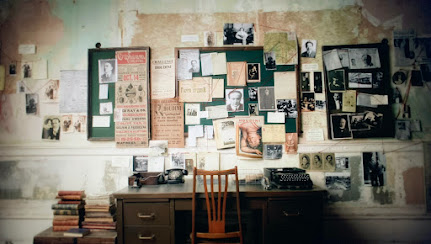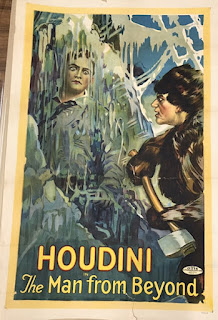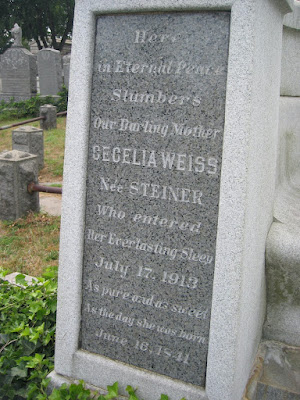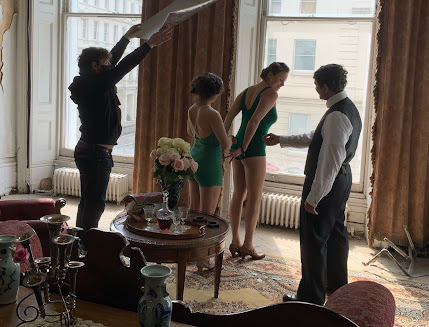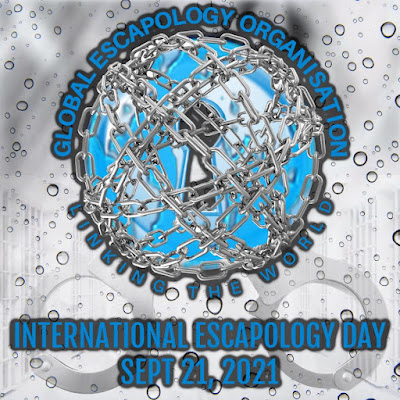It's probably the least known part of Houdini's storied career that he made several silent movies and even ran his own movie studio for a time. This may be because his foray into the movies is considered one of his few failures. But during the waning days of vaudeville his movies kept his name and exploits before the public and only increased his fame. And the fact that his movies are still screened and enjoyed 100 years later is certainly some form of cinematic success.
So for
National Silent Movie Day today, I thought I'd offer a rundown of Houdini's movies; the good, the bad, and how they can be seen today.
The Master Mystery (1918)
While Houdini had made a short film in Paris in 1909 (
Les merveilleux exploits de Houdini à Paris), his first real entry into narrative cinema was a 15-part serial called
The Master Mystery. Independently produced through Octagon Films,
The Master Mystery was shot in and around New York and New Jersey. The first episode debuted in November 1918. The serial was aggressively advertised with Houdini making
personal appearances at movie houses. It proved to be a surprising success, although Houdini would later have to sue Octagon for his share of the profits.
The plot of
The Master Mystery finds Houdini as Department of Justice agent Quentin Locke infiltrating International Patents who are buying up breakthrough inventions for the sole purpose of repressing them. One of these inventions is a hulking robot called The Automaton, who leads a gang against Locke at every turn. It's wonderful stuff with Houdini/Locke escaping two death traps per episode. The movie co-stars
Marguerite Marsh and
Ruth Stonehouse and was directed by Burton King. The Automaton is said to be cinema's
very first robot. I'll leave that for others to debate.
The Master Mystery was released on VHS in 1998 and then as part of Kino's
Houdini The Movie Star DVD set in 2008. That DVD is now out of print and the serial has yet to make it to streamers, but it can be found on YouTube. However, this commercial version is severely truncated, missing many escapes and some episodes entirely. The complete serial does survive in the collection of the
Packard Humanities Institute and can be viewed at the UCLA Archives. Here's hoping the full version will be released some day because it is a delight.
The Grim Game (1919)
The success of
The Master Mystery got the attention of Hollywood, and in 1919 Houdini headed to the coast to make
The Grim Game for Famous Players-Lasky. The movie was shot in and around Los Angeles and Hollywood and became newsworthy when two planes
collided in mid-air while filming a stunt. The footage of the plane crash would remain in the movie and featured heavily in advertising, although the fact that it was a stuntman and not Houdini involved in he accident was kept secret. The movie was directed by Irvin Willat and co-stars
Ann Forrest and
Mae Busch.
The Grim Game is well-tailored to Houdini and easily his best movie. The Hitchcockian plot still holds up today. Houdini plays reporter Harvey Hanford who sets out to prove the folly of circumstantial evidence by framing himself for the "murder" of his fiancée's uncle whom he knows is simply away on business. But when the man turns up dead, Hanford suddenly finds himself accused of the crime and in a master frame of his own creation that takes would take a Houdini to escape.
The Grim Game was considered a lost film until TCM acquired the last known print from collector Larry Weeks and debuted a restored version at the
TCM Classic Film Festival in Hollywood in 2015. The movie aired on TCM that same year. But it has never repeated and a planned DVD release never materialized. It is currently streaming on the
TV Time app. Here's hoping someone will license the home video rights, which are available via
Park Circus, and do a proper DVD release of this Houdini's best film.
Terror Island (1920)
Impressed by
The Grim Game, Famous Players-Lasky decided to rush a second Houdini movie into production before the end of 1919. Houdini postponed a European tour and returned to Hollywood to begin work on
Terror Island. The film was shot at the Lasky Hollywood studio and on location in
Riverside and
Catalina Island. This time the director was James Cruze and co-starred
Lila Lee.
Terror Island finds inventor Harry Harper (Houdini) seeking sunken treasure and the missing father of the heroine on a South Seas island populated by cannibals and criminals out to secure the treasure for themselves. The movie showcases innovative underwater photography, but even at the time the plot was considered old fashioned and more suited to a serial. The movie did not achieve the creative or commercial success of Houdini's previous work, and despite promises of more films to come, Terror Island marked his last Hollywood production.
Terror Island is available on
DVD,
streaming and
YouTube. However, this only surviving print, sourced from the Library of Congress, is missing two reels containing two of the movie's three escapes. So modern viewers must contend with this and the stereotypical portrayal of the natives typical of adventure movies of this era. But it's still Houdini and it does contain some classic early Hollywood thrills.
The Man From Beyond (1922)
Hollywood may have cooled on Houdini as a movie star, but Houdini was still willing to bet on himself. In 1921 he formed the Houdini Picture Corporation and produced two films back to back. The first was
The Man From Beyond, shot at the Tilford Cinema Studios in Manhattan and on location in Lake Placid, New Jersey, and Niagara Falls.
The Master Mystery director Burton King returned and Houdini's co-star was fellow vaudevillian
Jane Connolly in her only movie role. The script was written by Houdini himself and it shows.
The Man From Beyond tells the story of a man frozen in Arctic ice for 100 years. He's discovered by two explores and thawed out in 1920 where he meets the reincarnation of his long lost love. The film is a strange amalgamation of action and melodrama that reflects Houdini's growing interest in spiritualism at this time. While the entire enterprise seems amateurish, especially when compared to Houdini's Hollywood productions, it's still a compelling document of Houdini's psyche and the thrilling climax at Niagara Falls still holds up.
The Man From Beyond has always been the Houdini film most accessible to the public. Prints were sold in 16mm and 8mm as early as the 1960s. It was also released on VHS by
Video Yesteryear in the 1980s. Today several versions are available on
DVD and there's even a
Blu-Ray restoration. It's also available for
streaming and on
YouTube.
Haldane of the Secret Service (1923)
The second and last movie made by the Houdini Picture Corporation was
Haldane of the Secret Service. The movie was shot in and around New York in 1921. Additional footage taken during Houdini's European tour the previous year was incorporated into the film to give it a globetrotting flavor. Burton King returned to direct, although his name does not appear on the surviving credits. Houdini is now generally credited as director, writer and star.
Gladys Leslie co-stars. While Houdini distributed
The Man From Beyond via state rights,
Haldane was released by FBO in 1923.
Haldane of the Secret Service returns to formula action with Houdini playing Department of Justice agent Heath Haldane on the trail of counterfeiters and a mysterious gang boss known as Mr. Yu. The movie isn't as bad as its reputation, and Haldane/Houdini's escape from a giant water wheel is one of his best. However, the movie was poorly received and even Houdini didn't do much promotion for it. But by 1923 he was on his way to a new career exposing fraudulent mediums and happy to leave movies behind.
Haldane of the Secret Service was unavailable for many years until a complete print was screened at the
Silent Movie Theater in Los Angeles in 2007. This led to a
DVD release. Today it can be found on
streaming and on
YouTube.
I hope you enjoyed this brief retrospective of Harry Houdini's silent film work. Happy National Silent Movie Day!
The Man From Beyond poster image courtesy the Harry Ransom Center at the University of Texas, Austin.
